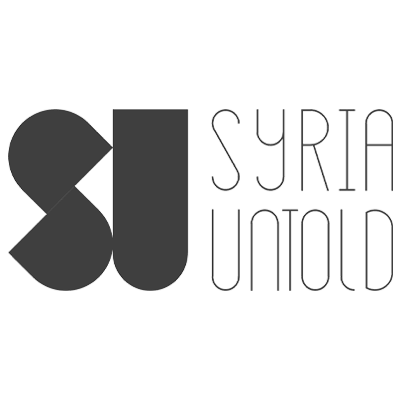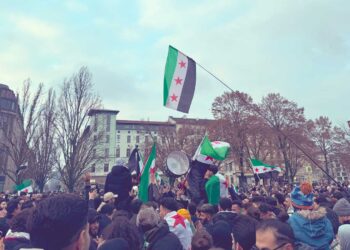In December 2015, a disturbing video surfaced on social media. In it, Israeli Orthodox Jews are celebrating at a wedding in Jerusalem, the killing of a Palestinian toddler. As they stabbed the toddler’s photo, they conveyed their intentions of revenge and harm towards other Palestinian infants.
A few months earlier, the toddler, Ali Dawabsheh (18 months old) was burned to death when settlers set fire to his family house in Duma village, south of Nablus city in the occupied West Bank. The house was then spray-painted with the words “Revenge” and “Long Live Messiah the King” alongside a Star of David. The parents later succumbed to their injuries in the hospital.
Many condemned the video of the dancing youths, chanting and celebrating Dawabsheh’s death with guns and knives, but what strikes in the wedding video is the incorporation of rock music and dancing, which amplifies the violence and aggression of that moment. In this context, music not only acts as an auditory element, but also as a communal activity that builds a shared experience among a group against a common “enemy”. Psalm verses, “infidels’ roar”, and prayers for vengeance transform the emotional atmosphere into a quasi-religious ritual, deepening the collective sentiment and group harmony. This reinforces collective identity but also normalizes violence and cultivates a shared mindset of hatred.
This video illustrates how songs and collective celebrations can become spaces for expressing violence and hatred. Music, often celebrated for empowerment, unveils a darker side in Ali Dawabsheh’s story, where it plays a crucial and active role in promoting enmity toward the Palestinians.
Although this incident occurred a few years ago within what can be considered an extreme context at the time, one cannot ignore its resonance with current mainstream videos, songs and TikTok trends circulating on Israeli social media during the ongoing war on Gaza. These popular expressions carry not only hateful and violent messages but, in some instances, verge on the genocidal. Importantly, this current wave is not limited solely to extremist settlers but extends across broader segments of Israeli society through social media posts and music productions.
Songs play a significant role in shaping public opinion, identities, and attitudes in most cases. When they circulate widely on social media and contain inflammatory rhetoric, they can transport listeners into a world of patriotism, extremism, and aggression, with the desire to overpower and annihilate the enemy. They become an integral part of propagandist tools and militainment—entertainment featuring and celebrating the military. Examining songs or performances thus allows us to trace how they reflect the conceptions and imaginaries of a community and actively shape it. More importantly, analyzing it through the lenses of individual subjectivity along with collective identity reveals how music generates and constructs shared experiences. This is particularly true in times of war to dissect the narrative and symbols embedded in them, tracing their contribution to the war discourse and ultimately, cultivating an environment conducive to violence, dehumanization, and erasure.
From lullaby to torment: unmasking a disturbing weapon
Music and songs have frequently served as expressions of nationalistic feelings and extreme ideologies, particularly in times of war. However, in a context of extreme mobilization and militarization, the weaponizing of music and its use as a tool of erasure and a conduit for hate messages that contribute to the war effort and incite violence, becomes even more pronounced and alarming. This is particularly evident in the case of Israel’s aggressive assault on Gaza, where Israel stands as a dominant, militarized, and powerful state, which strives to shape the local and the global discourse while inflicting widespread destruction on Gazan neighborhoods, schools, hospitals, and carrying out massacres.
In the initial days of the war on Gaza, a troubling trend surfaced on TikTok, originating from a video depicting Israeli soldiers abusing and subjecting blindfolded Palestinian detainees in the occupied West Bank to the relentless repetition of a children’s song “Meni Mamtera” by the singer Meni Tzukerl, as documented by the Palestinian writer and analyst Muhammad Shehada. The Israeli media cynically called it a “humorous and original story” and “Israel’s secret weapon”, as it was used to force the detainees to listen to this song for more than eight hours. Some were further humiliated by being obliged to chant “Long live Israel” or carry the Israeli flag, amplifying their sense of powerlessness and impotence. The trend not only minimized the traumatic experiences of the detained and tortured Palestinians, but also incited mockery as Israelis filmed and shared videos mimicking these degrading actions to the lullaby’s tune.
Even a former Knesset member and a program host on Israel’s Channel 14, Yinen Magal, reenacted the scenes with his own children. An Israeli soldier posted a TikTok video singing while transporting blindfolded Palestinian detainees as part of another TikTok challenge to kidnap and blindfold Palestinians. The lullaby was also played at weddings, where participants simulated detainees by sitting blindfolded and listening to the song, and the singer Meni Tzukerl was celebrated as a “national hero”.
The initial prisoner videos show Palestinian detainees enduring more than just physical abuse and violence on their bodies. The relentless exposure to hours of repetitive music subjects them to a form of degradation that infiltrates their hearts and minds. Incapable to speak or see, the prisoners are stripped of their human existence, reduced to mere bodies devoid of feelings or political rights, making their suffering insignificant. Beyond the evident violation of the detainees’ humanity and dignity in these initial videos, the lullaby TikTok trend utilizes the same playful or innocent tune to mock their suffering as subhuman. The repetitive and cumulative use of this song desensitizes viewers to the profound suffering of the prisoners, minimizing the severity of the situation and normalizing their mistreatment.
In these different videos, the prisoners have no face, no life stories, no voice, all that remains is an Israeli song, torturing anonymous bodies… Taken outside of time, space and humanity, the prisoners are excluded from both human and political communities, treated as dispensable entities without rights or protections. Palestinian stories and voices are once again erased and made invisible and muted, while the Israeli narrative and vision are overly imposed. As a result, these videos contribute to the silencing of the Palestinians, their systematic dehumanization and the normalization of violence.
Furthermore, in a context of a continuous portrayal of the Palestinians as barbaric and “human animals” in the Israeli discourse, the TikTok trend legitimizes Israeli crimes against them and rationalizes acts approaching genocide.
Sounding aggression in popular culture
In this disturbing environment, music video clips use music, lyrics, visuals, and cultural symbols to disseminate ideas that either endorse or incite mass murder. One notable example is the song “Harbu Darbu” by the Duo Ness Ve Stilla Nesia, which was released during the ongoing war, and gained widespread popularity in Israel. Dominating music platforms for weeks, it reached number one on the Israeli streaming platform singles chart hitlist.
The expression “Harbu Darbu” originating from Syrian Arabic and meaning “war and strikes,” is actually a call in Hebrew slang for “raining hell” on Israel’s opponents. The song employs derogatory terms, calling Palestinians “rats and sons of Amalek”. This reference to an ancient tribe, portrayed in the Torah as the eternal enemy of the Jewish people that needs to be annihilated, echoes the words of the Israeli Prime Minister Benjamin Netanyahu at the start of the ground invasion of Gaza. It reflects how political statements can circulate, infiltrate the mind and reappear in popular culture. This biblical reference has long been used by the Israeli far right to justify violence against Palestinians. In this war, it serves to justify the brutal assault on Gazans and add a religious connotation to the war. This is clear in another video shared on X (formerly Twitter) by Israeli journalist Yinon Magal, showing soldiers advocating the occupation of Gaza and calling for the eradication of the “seed of Amalek”, while denying the existence of “innocent civilians” in Gaza.
In this general narrative, everyone in Gaza becomes a target, justifying the collective punishment and the legitimate annihilation of the entire population, as chanted in the song “Harbu Darbu”. The song not only glorifies the soldiers but also applauds the IDF’s massive military aggression over Gaza, calling for more destruction, military actions and displacement. As it praises the inscription of Israeli children’s names on bombs dropped on Gaza, it paints a picture of a society striving for revenge and ready for battle. The trap music of the song further intensifies the atmosphere with its quick tempo and rhythmic patterns. Set to a drill beat that accentuates aggression, the singers “spit” on those who call for a “Free Palestine”, praise their erasure and end the video with a message in Arabic stating “every dog’s day will come”.
The song’s success is reflected in its excessive use in a trend on TikTok. Many Israelis made videos using the song to show their support for the war. As they dance and salute the military, they also chant “one two … shoot” while mimicking shooting gestures with their hands. Others praised the song as a source of healing for the Israeli youth, considering it a way to overcome the depression of the early days of the war by channeling and expressing anger. Indeed, Hamas’ attack on 7 October left the Israeli society in shock, creating the “depression” experienced in the early days. However, the song expresses very well how this depression quickly turned into a prevailing, general will, not only to crush Hamas, but to extract revenge on all Palestinians and erase Gaza, reflecting a determination to restore Israel’s image and ensure its security through a new Nakba imposed on the entire Palestinian population.
“The friendship song 2023”: A disturbing narrative of war and nationalism
But songs do more than convey hate and violent messages; they also facilitate crafting historical narratives and promote shaping extreme nationalist identities, especially in times of war, as exemplified by the “Friendship song 2023”. Sung by Israeli children, and co-written by Shulamit Stolero and Ofer Rosenbaum, the chairperson of the Civil Front, the composition provoked controversy and outrage. It was created for the purpose of supporting the war effort by the Civil Front, which, despite its seemingly “civic” name, is an Israeli group, formed after 7 October, to mobilize the Israeli society to support the war on Gaza. The video was removed from YouTube for violating its terms of services. It was also shared, then quickly removed by Kan, an Israeli state-owned news channel, after the angry global responses it received.
The song is an adaptation of a renowned poem and song from 1949, commemorating Jews killed during the establishment of the Israeli state, one year after the Palestinian Nakba. The 2023 version serves as an affirmation and reconstruction of the foundational moment of 1948 Israeli identity in the aftermath of the Shoah. Rejoining the two historical moments of the post Nakba to the current moment, of the ongoing war against Gaza, serves as a significant element in forming and crafting the country’s narrative and history.
The video features children singing, their faces turned towards each other and sometimes directly to the camera. In a few scenes, the Israeli flag in the background enhances the moments of nationalistic sentiments. The opening stanza paints a serene picture of an “Autumn night” over the beach of Gaza, accompanied by the innocent and calm singing of the children. However, this tranquility is shattered by lyrics calling for bombing and destruction, accompanied by imagery portraying the devastating erasure of Gaza. As the music accelerates, the song envisions a future where, after eliminating the Palestinians, Israeli soldiers will return home to cultivate their fields following the annihilation of everyone in Gaza.
The second stanza starts with an emotional description of a “love sanctified with blood”, expressing the nation’s cry and fight. The nationalistic discourse is reinforced in the declaration of “one people, The people of forever evermore.” By drawing a historical and metaphorical parallel between Palestinians, the “Swastika-bearers”, and the Nazis, the memories of the Holocaust are used to equate Palestinians with the Nazis and to reinforce the animosity against them. Like the Amalek reference in “Harbu Darbu”, this comparison subtly alludes to Israel as a persecuted nation, with natural and historical rights to the land, hence its duty to protect it. Despite this alleged vulnerability and victimhood, the military-themed music and language mixed with brutal visuals— including bombs, airplanes, the Israeli flag, soldiers in action or mourning, collapsing buildings, and aerial footage of bombings— promote a narrative of violence, displacement, and military superiority, while portraying Palestinians as eternal enemies, and justifying destructive acts against them.
The collective voice of children contributes to constructing a future and a collective narrative. Associated with the establishment of Israel and the memory of the Shoah, it reminds the Israeli audience of an imagined historical continuity: from a past of independence after a long-victimized history, to a present where the Israeli nation faces a renewed threat (of the “Swastika-bearers”), it envisions a future of victory after the enemy’s erasure.
In this process, the song not only legitimizes the killing and elimination of the eternal enemy, but also shapes extreme nationalist sentiments and deforms historical realities. It affirms the dominance of the Israeli historical narrative, placing significant emphasis on the beginning of a new/old chapter on 7 October. Ironically, in the meantime, any attempt to contextualize historically the Palestinian narrative including their suffering and loss is still denied and erased, particularly during this war, as if Palestinian experiences since the Nakba never existed or truly do not matter.
Unveiling hate narratives in the Israeli war on Gaza
The exploration of hate-laden narratives in the Israeli soundscape during times of war reveals a violent landscape marked by explicit threats, erasure, and the dehumanization of the Palestinians. These elements foster a culture of hatred and aggression, aggravating the ongoing war on Gaza. They often shape the narrative by framing it as an eternal religious conflict or de-historicizing the colonial struggle. Yet, it remains crucial to grasp their intent to incite violence within the context of war, forced displacement, and explicit calls for mass killing. This is particularly true when the intended audience can decode the messages and understand the metaphors.
From a legal perspective, proving genocide is already a complex challenge, particularly when the mass killing of civilians is presented as acts of self-defense against security threats, and the complete destruction of Gaza and Gazans is framed as a pursuit of “victory” over Hamas rather than the “systematic destruction” of an entire population.
Establishing intent for genocide becomes even more complicated when dealing with hate-filled songs or messages. However, drawing parallels with precedents such as the International Criminal Tribunal for Rwanda’s ruling on songs like “I hate these Hutus” by the Hutu artist Simon Bikindi recognized as incitement to genocide, strengthens the argument that music and media can significantly contribute to the broader landscape of conflict, hatred, and violence in the Israeli war on Gaza context.
In her work on the impact of radio broadcast on genocidal rhetoric, Carole Pauli, a Professor at Texas A&M University Law School, identifies interconnected factors that effectively promote hatred against minorities and encourage calls for harm. In order to decode media messages that form incitement to genocide, and urge other states to intervene and stop the crime, she elaborates a seven factors framework. Among these factors, she observes the existence of competing media channels disseminating messages of hatred, political instability, the influential role of leaders in spreading harmful narratives and their authoritative image, the audience’s vulnerability, and the immediacy and power of the communication channel.
While some may argue that isolated incidents, like the 2015 video depicting Ali Dawabsheh’s stabbing, are “deviations” condemned even among segments of the Israeli society, the prevalence of hate-laden songs and videos on the Israeli social media during the ongoing war on Gaza suggests a normalization of such brutal actions.
This normalization is already spread in the general language used by Israeli politicians amidst an ongoing mass killing in Gaza of more than 26,000 people, the ethnic cleansing and the displacement of 1.9 million people (85% of the total population of Gaza), all while the world is watching. Songs like “Harbu Darbu” and “The Friendship Song 2023” utilize the media to intensify the militant and dehumanizing narrative, cultivate hatred, and foster a thirst for revenge among listeners in a context of mass violence described by many genocide scholars as indeed a genocide.
The interplay between media, politics, and music in this context stresses the urgent need to address and challenge hate narratives spread in popular culture. Their prevalence not only reflects the fragility of human rights discourses but also raises questions about our capacity to prevent or stop war crimes and genocide (along with incitement). It prompts us to reconsider the Genocide Convention, which fails to deem modern states’ discourse and warfare as illegitimate, particularly as in the case of a settler colonial state that attempts to erase a people, its history, and its narrative since 1948.








